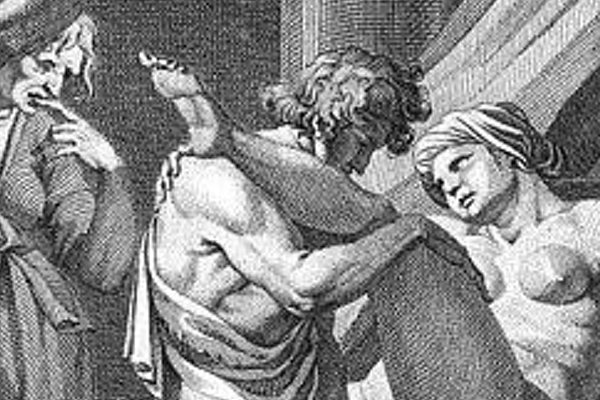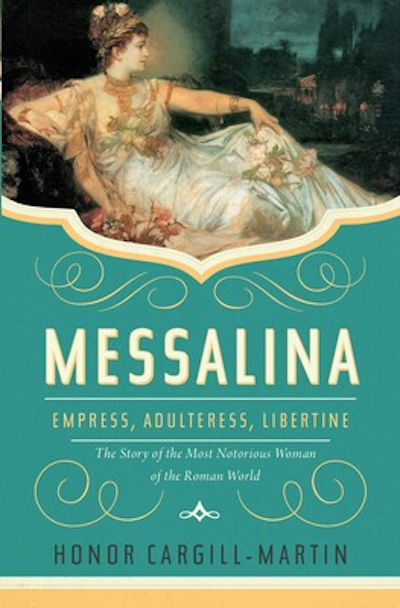Recovering the Story of the Empress Messalina After a Roman Cancellation

From "Messaline Dans La Loge de Lisisca," Agostino Carraci, 16th c., depicting the rumored moonlighting of the first-century empress in a Roman brothel.
Towards the end of 48 CE a workman carried his tools down into a tomb on the outskirts of Rome. Among the rows of niches, he found the urn holding the ashes of Marcus Valerius Antiochus. He had been a hairdresser and the freedman of the empress Valeria Messalina – a fact he had been proud enough of to record on his tombstone. The workman took out his tools; his job that day was to chisel off the empress’s name.
Messalina had been killed that autumn, in the midst of a scandal that had rocked Rome. She’d been accused of bigamously marrying one of her lovers and plotting to oust her husband, the emperor Claudius, from the throne. The real reason for Messalina’s fall probably lay more in the power plays of court politics than in some grand, mad, bigamous passion, but it didn’t matter. A succession of her alleged lovers were executed, and then, fearing that Claudius might be swayed by love for his wife, an imperial advisor ordered that Messalina herself be killed before she had the chance to plead her case.
Tacitus, the great historian of Roman tyranny, recorded that Claudius hardly reacted when the news of his wife’s death was brought to him at dinner –– he simply asked for another glass of wine. Claudius seemed to want to forget completely, and the senate was willing to help him. They decreed that every trace of Messalina –– every image of her, and every mention of her name –– should be destroyed. It was only the second time in Roman history that an official order of this kind, now referred to as damnatio memoriae, had been passed. The decree applied to both the public and private sphere; statues of Messalina were dragged off plinths in town-squares and domestic atria before being smashed, or melted down, or recut. Mentions of her name were rubbed off official records, and chiselled equally off honorific monuments and hairdressers’ epitaphs.
Damnatio memoriae has sometimes been referred to as a form of ancient Roman “cancel culture,” but this was a process utterly unlike modern cancellation –– one that could not be replicated today. In the age of the internet someone might be unfollowed, their invitations to speak at official events rescinded, they might be attacked in op-eds. Their name might even become unmentionable in certain circles. But while the reach and influence of “the cancelled” might be reduced, the evidence of their existence and actions cannot be destroyed. Their government records and Wikipedia pages still record their birthdate; their tweets, however dodgy, are still cached in some corner of the internet. They can post videos of themselves crying and apologizing, tweet a glib brush-off, or publish ten-thousand-word tracts of self-justification. The cancelled might be dismissed, but they cannot be erased.
The situation was different in 48 CE. The sources of information about Roman political figures were less varied and more traceable than they are today –– and the mediums through which such information was disseminated, generally more smashable.
The public image of imperial women like Messalina was carefully controlled. Official portrait types were developed, copies of which were sent off to cities throughout the empire, where they were copied and recopied again for public buildings, shop-windows, private houses. These statues, along with coin types and honorific inscriptions, were designed to present Julio-Claudian women as icons of ideal Roman femininity and imperial stability. Messalina’s best-preserved portrait is almost Madonna like – she stands, veiled, balancing her baby son Britannicus, then heir to the empire, on her hip; coins minted in Alexandria depict the empress as a veiled fertility goddess, carrying sheaves of corn that promise the prosperity of imperially protected trade routes. Such a coherent image could be destroyed almost wholesale – especially when driven by an official, central edict rather than simply by a shift in popular consensus; there is only one surviving statue of Messalina that was not discovered pre-broken by the conscientious minor officials of the mid-1st century.
So where does this leave the historian? At first glance the situation is dire –– our information about imperial Roman women is always limited, and in this case much of that information has been purposefully and systematically destroyed. On reflection, however, it is more complex; the destruction of Messalina’s images and honours had created a vacuum and an opportunity.
The official narrative of the Julio-Claudian rulers, expressed in stone and bronze, was always supplemented by a secondary, ephemeral narrative of rumor. This was a period that saw politics move ever more away from the public arenas of the senate and the assembly into the private world of the imperial palace as power was ever-increasingly concentrated in the figure of the emperor. The women of the Julio-Claudian family were central to this new dynastic politics; they had access to the emperor that senators could only dream of, and all the while they were raising a new generation of potential heirs to the imperial throne. As the opacity of the new court politics encouraged ever more frenzied speculation about the private lives and intrigues of its players, much of that speculation came to center on the women.
Messalina’s dramatic and sudden fall from grace had raised questions and, in leaving her memory and reputation unprotected, the process of damnatio memoriae allowed people to propose answers. Rumours of the empress’ political and sexual conduct –– some of which may have been circulating during her life, some of which must have evolved after her death –– could now be openly discussed, elaborated upon and written about.
The result is an extraordinarily rich tangle of reality and myth. The sources are almost certainly right to accuse Messalina of orchestrating her enemies’ downfalls and deaths (no one could survive almost a decade at the top of the Julio-Claudian court without a little violence); their attribution of such plots to sexual jealousy and “feminine” passion rather than to political necessity is more suspect. Similarly, there is no reason to believe ancient writers totally unjustified in accusing Messalina of adultery; their claims that she slipped out of the palace nightly to work in a low-class brothel, or that she challenged the most notorious courtesan in Rome to a competition of who could sleep with more men in twenty-four hours (and won with a tally of twenty-five) are far more difficult to credit.
The unravelling of these stories is both the challenge and the joy of ancient history. The process is also revealing on two counts. The evaluation of these stories brings us closer to re-constructing the narrative of Messalina’s real life, her history, and her impact on her times. But even those tales that cannot be credited are of value. The stories and rumours that Rome constructed about its most powerful women when given totally free rein tell us a great deal about its contemporary culture and society –– its anxieties, its prejudices, its assumptions, and its desires.
